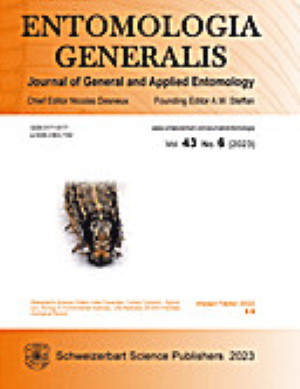评估美国 Halyomorpha halys 生物防治的地理范围
IF 4.6
1区 农林科学
Q1 ENTOMOLOGY
引用次数: 0
摘要
生物控制通常是入侵物种管理策略的关键组成部分。然而,对天敌生态学的不了解可能会限制生物防治的效果。为了克服这一问题,栖息地适宜性模型可以预测入侵物种的分布,并确定入侵者与天敌之间的潜在重叠区域,从而指导生物防治。在这里,我们利用一个协调的国家监测网络的数据和一种将生理学纳入相关生态位模型的新型建模方法,预测了褐狨蝽和两种天敌(一种寄生虫日本蝽和一种小孢子虫马多西蝽)在当前和未来气候条件下(2070 年代)的潜在分布。我们的研究表明,这三个物种在栖息地适宜性方面具有广泛的相似性,尤其是在H. halys种群最初建立的美国大西洋中部和东南部地区,其重叠程度更高。未来,每个物种都可能在美国北部扩大其分布范围,但物种间的重叠可能会减少。在美国中部和东南部的大部分地区,哈雷虫的分布范围可能会随着时间的推移而缩小,但天敌受到的影响可能较小,物种间的重叠可能会增加。我们的研究表明,日本蓟马和马多溪蓟马提供的生物防治可能是管理哈雷虫的关键,因为它们的生态位重叠,我们的模型可以帮助划定生物防治可能最有效的区域。我们将野外数据与相关生态位模型联系起来的方法也可用于其他昆虫。本文章由计算机程序翻译,如有差异,请以英文原文为准。
Assessing geographic dimensions of biological control for Halyomorpha halys in United States
Biological control is often a key component of management strategies for invasive species. Yet, the effectiveness of biological control can be limited by a poor understanding of natural enemy ecology. To overcome this, habitat suitability models can predict distributions of invasive species and identify areas of potential overlap between invaders and natural enemies to guide biological control. Here we used data from a coordinated national monitoring network and a novel modeling method that incorporates physiology into correlative niche models to predict potential distributions of the brown marmorated stink bug, Halyomorpha halys, and two natural enemies (a parasitoid, Trissolcus japonicus, and a microsporidian, Nosema maddoxi) in current and future climates (2070s). We show all three species have broad similarity in habitat suitability, with especially high overlap in the mid-Atlantic and southeastern US where H. halys populations were first established. Each species will likely expand their range across the northern US in the future, but the overlap between species may decrease. In much of the central and southeastern US, H. halys may decrease its range over time, although natural enemies may be less impacted, and overlap between species may increase. Our study shows that biological control provided by T. japonicus and N. maddoxi could be key for managing H. halys given their overlapping niches, and our models can aid in delineating areas where biocontrol may be most effective. Our method of linking field data with correlative niche models can also be used for other insects.
求助全文
通过发布文献求助,成功后即可免费获取论文全文。
去求助
来源期刊

Entomologia Generalis
生物-昆虫学
CiteScore
7.10
自引率
18.80%
发文量
72
审稿时长
>12 weeks
期刊介绍:
Its scope covers all aspects of basic and applied research dealing with insects and more broadly with arthropods inhabiting wild, agricultural and/or urban habitats. The journal also considers research integrating various disciplines and issues within the broad field of entomology and ecology.
Entomologia Generalis publishes high quality research articles on advances in knowledge on the ecology and biology of arthropods, as well as on their importance for key ecosystems services, e.g. as biological control and pollination. The journal devotes special attention to contributions providing significant advances (i) on the fundamental knowledge and on sustainable control strategies of arthropod pests (including of stored products) and vectors of diseases, (ii) on the biology and ecology of beneficial arthropods, (iii) on the spread and impact of invasive pests, and (iv) on potential side effects of pest management methods.
Entomologia Generalis welcomes review articles on significant developments in the field of entomology. These are usually invited by the editorial board, but proposals may be sent to the Editor-in-Chief for preliminary assessment by the editorial board before formal submission to the journal. The journal also considers comments on papers published in Entomologia Generalis, as well as short notes on topics that are of broader interest.
 求助内容:
求助内容: 应助结果提醒方式:
应助结果提醒方式:


